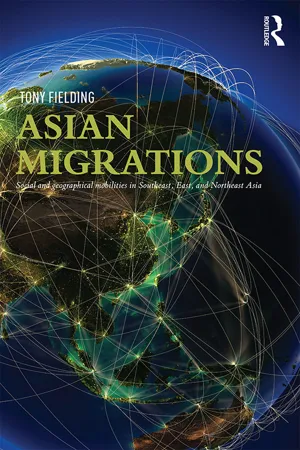History
Japanese Immigration
Japanese immigration refers to the movement of Japanese people to other countries, particularly in the late 19th and early 20th centuries. This migration was driven by economic opportunities and labor demands in countries such as the United States, Brazil, and Canada. Japanese immigrants faced challenges such as discrimination and restrictive immigration policies in their new homelands.
Written by Perlego with AI-assistance
Related key terms
1 Key excerpts on "Japanese Immigration"
- eBook - ePub
Asian Migrations
Social and Geographical Mobilities in Southeast, East, and Northeast Asia
- Tony Fielding(Author)
- 2015(Publication Date)
- Routledge(Publisher)
th centuries was quickly translated into military might. Following military successes against China (1895) and Russia (1905), and the full annexation of Korea (1910) and Manchuria (1932), Japan had invaded and occupied almost all of East and Southeast Asia, and the whole of the western Pacific by 1942. The astounding ferocity of this onslaught, especially in China, led to major losses of life and to massive displacements of population. How could people protect themselves and their families from air raids, ‘scorched earth’ destruction or fierce punishment for resistance, except by fleeing? In addition, workers were commandeered and relocated all over East Asia to support the Japanese war effort. Neither the nationalists (KMT) or the communists in China, nor the European colonial powers in Southeast Asia could hold out against Japan’s armed forces (witness the fall of Nanjing and the ignominious surrender of the British in Singapore). However, the USA (following the attack on Pearl Harbor and having interned its Japanese-American population) could, and did resist, and when in the end Japan was itself about to be invaded, and its city populations became the victims of horrific thermo-nuclear attack in 1945, it surrendered.The ending of the Japanese imperial gamble had a significant migration effect. About 6 million Japanese nationals, members of the armed forces and civilians, returned to Japan in the months following the end of the war, and in the five years before the outbreak of the Korean War, 1.5 million Koreans returned to their home country from Japan. Many Koreans, however, remained stranded in China and the Soviet Union.2.5 Conclusion: the implications of this history for an understanding of migrations in East Asia todayOne can usefully speculate on the multiple influences of this history on the nature and distinctiveness of migration regimes in East Asia today. First, though, I should introduce a word of caution. I am not claiming that these historical legacies produce unique outcomes in our region, but rather that certain migration characteristics, found also in other parts of the world, take on a particular significance in East Asia, or connect together in particular ways in East Asia, and that they do so partly as a result of the ‘burden’ of this history.1
Learn about this page
Index pages curate the most relevant extracts from our library of academic textbooks. They’ve been created using an in-house natural language model (NLM), each adding context and meaning to key research topics.
